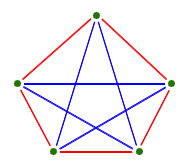- Your fractal homework is returned. Ouch!
Here's a good solution -- thanks Dave!
You all need some fractal practice. We'll start with that today.
- "NKU student opera huge hit! Cast headed for Broadway, led by Kyle Heinrich!"
I hope that you had a chance to see Kyle in action....
- You have a new assignment, due Monday.
- Alert: our second exam is next week, Friday.
- We reviewed Euler's solution to the Konigsberg bridge problem.
- We talked about simple graphs -- those without duplicate edges (duplicate bridges) and loops (bridges from a land mass to itself!
- We related simple graphs to social situations such as Facebook, where two people are either friends or not.
- Graphs don't change by bending edges, but breaking them or
detaching edges from their vertices (and hence creating new vertices)
gives new graphs.
- A graph is simple if it doesn't have any loops (edges connected
from a vertix to itself), or multiple edges with the same two vertices.
Now: how might we relate this concept to Facebook?
- Last time we drew all the simple graphs with one, two,
and three vertices.
For these graphs we ignore the differences between people. All vertices are considered the same.
- Let's review the simple graphs with four vertices.
- Have you ever seen any of these before? Could we give any of them names?
- Planar graphs are graphs that can be drawn such that no two edges
intersect.
- Complete graphs are simply graphs with connections between
every pair of vertices (but no loops).
- Exercise: Let's see if we can show that the complete graph
with five vertices is not planar:

- Chapter 3: The Enemy of My Enemy (complete graphs)
- The focus of this reading is negative numbers. The
Indians also put negative numbers on a firm foundation (as
well as zero), in about the 6th century AD.
"...you can't see negative 4 cookies and you certainly can't eat them -- but you can think about them...." ("and you have to", says our author! p. 15).
- One of the confusing aspects of negative numbers
from Strogatz's perspective is that the product of two
negative numbers is a positive number. The story about
the two linguists is priceless (p. 17).
- But then Strogatz goes on to use the context of
social interactions (negative and positive) to discuss
how we maintain stable relationships.
And the key to understanding stability in three-way social relationships is that the product of two interactions (signified by either +1 or -1) must be equal to the other: so that if two legs are positive, the third in the triangle must be positive; if one leg positive, and the other negative, then the third leg must be negative as well.

Strogatz sums up the second case above in the familiar saying that "The enemy of my enemy is my friend".
The following (two) graphs are unbalanced:

Finally Strogatz shows how historical relationships settled down into this pattern of stability: in "...the run-up to World War I. The diagram that follows shows the shifting alliances among Great Britain, France, Russia, Italy, Germany, and Austria-Hungary between 1872 and 1907."

The bottom right graph (complete!) is the only stable configuration, "...balanced, but on the brink of war."
- The focus of this reading is negative numbers. The
Indians also put negative numbers on a firm foundation (as
well as zero), in about the 6th century AD.

